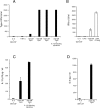Mouse plasmacytoid cells: long-lived cells, heterogeneous in surface phenotype and function, that differentiate into CD8(+) dendritic cells only after microbial stimulus
- PMID: 12438422
- PMCID: PMC2193989
- DOI: 10.1084/jem.20021031
Mouse plasmacytoid cells: long-lived cells, heterogeneous in surface phenotype and function, that differentiate into CD8(+) dendritic cells only after microbial stimulus
Abstract
The CD45RA(hi)CD11c(int) plasmacytoid predendritic cells (p-preDCs) of mouse lymphoid organs, when stimulated in culture with CpG or influenza virus, produce large amounts of type I interferons and transform without division into CD8(+)CD205(-) DCs. P-preDCs express CIRE, the murine equivalent of DC-specific intercellular adhesion molecule 3 grabbing nonintegrin (DC-SIGN). P-preDCs are divisible by CD4 expression into two subgroups differing in turnover rate and in response to Staphylococcus aureus. The kinetics of bromodeoxyuridine labeling and the results of transfer to normal recipient mice indicate that CD4(-) p-preDCs are the immediate precursors of CD4(+) p-preDCs. Similar experiments indicate that p-preDCs are normally long lived and are not the precursors of the short-lived steady-state conventional DCs. However, in line with the culture studies on transfer to influenza virus-stimulated mice the p-preDCs transform into CD8(+)CD205(-) DCs, distinct from conventional CD8(+)CD205(+) DCs. Hence as well as activating preexistant DCs, microbial infection induces a wave of production of a new DC subtype. The functional implications of this shift in the DC network remain to be determined.
Figures







References
-
- Eckert, F., and U. Schmid. 1989. Identification of plasmacytoid T cells in lymphoid hyperplasia of the skin. Arch. Dermatol. 125:1518–1524. - PubMed
-
- Siegal, F.P., N. Kadowaki, M. Shodell, P.A. Fitzgerald-Bocarsly, K. Shah, S. Ho, S. Antonenko, and Y.J. Liu. 1999. The nature of the principal type 1 interferon-producing cells in human blood. Science. 284:1835–1837. - PubMed
-
- Cella, M., D. Jarrossay, F. Facchetti, O. Alebardi, H. Nakajima, A. Lanzavecchia, and M. Colonna. 1999. Plasmacytoid monocytes migrate to inflamed lymph nodes and produce large amounts of type I interferon. Nat. Med. 5:919–923. - PubMed
-
- Cella, M., F. Facchetti, A. Lanzavecchia, and M. Colonna. 2000. Plasmacytoid dendritic cells activated by influenza virus and CD40L drive a potent TH1 polarization. Nat. Immunol. 1:305–310. - PubMed
MeSH terms
LinkOut - more resources
Full Text Sources
Other Literature Sources
Research Materials

